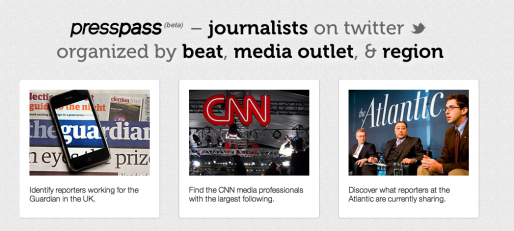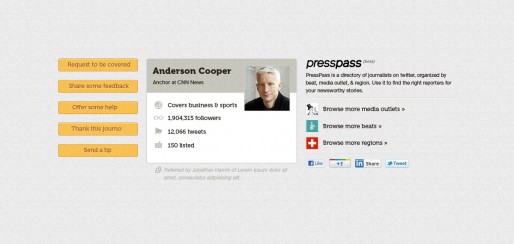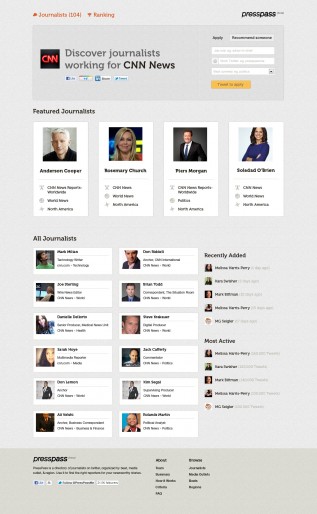
Canadian-born entrepreneurs who packed up and headed to Dubai, David Haddad and Valencio Cardoso dreamed of a way to connect journalists and the public at large. Their end result, PressPass.me, leverages Twitter to connect journalists with tipsters and other members of their community. Currently in the initial phases of launch, Press Pass is already planning its first pivot — to focus less on aggregating journalist tweets and instead have an open directory of journalists across the globe, including media stars like Anderson Cooper, Rachel Maddow and David Pogue, segmented by media outlet, beat and region. ONA caught up with co-founder Valencio Cardoso to discuss how the platform improves upon Twitter, the benefit to targeting the U.S. market, and “pleasant discoverability experiences.”
Who do you think is the ideal user for this service?
I see people who need help in getting their message to the public through press coverage and the news utilizing the directory –- startups, small businesses, Kickstarter projects, artists, non-profits, etc.
That being said, once we start adding journalists from different countries, I can also see it being used by journalists themselves to find and reach out to other reporters in regions they’re interested in covering.
Why did you place a strict definition around journalist? In this day and age, a lot of key influencers are outside of traditional media and broadcast outlets.
We wanted to focus on journalists because they follow a certain code of ethics, and are a trusted source of vetting the information they put out to the public.
Moving forward, we do have plans to broaden our directory to include credible bloggers and digital influencers internationally, in addition to creating easier ways for members of the public to formulate coverage requests and discover relevant journalists to reach out to through Twitter.
How do you curate what each journalist “shares” on your site?
At the moment, we follow the tweets of the journalists in our directory and analyze them. Each of the journalist’s profiles on Press Pass is created based on what articles they are sharing on Twitter, the topics they care about and who they’re talking to, with the idea being that people would get a better understanding of the type of information each particular journalist is interested in.
However since we launched (a month ago), most of the positive response we’ve received from journalists and the community was that they really liked the idea of an international open and organized directory of journalists from different regions and media outlets. Improving based on user feedback, we’re in the midst of launching a redesign (see images below) that will shift us away from tracking journalist’s tweets to focusing on building a global directory of journalists.
The site is very user friendly and heavily visual — how did you come up with the design elements? Did you use a service, or did you employ an in-house designer? What do you want the user to experience?
I’m glad you like the look and feel of it! The entire platform was designed and built by both David and me. We come from tech backgrounds -– David’s a software engineer and I’m an interactive designer so we were able to create Press Pass together.
The design elements were based on our personal preferences of style, textures, fonts and icons. But in terms of user experience, we thought about how people would want to browse the website and what information they would find important in order to move to the next step. We intended to keep things very simple, whilst making the process of finding relevant journalists a pleasant discoverability experience.
Where did the ranking feature come from? Why do you believe that is useful to your users?
The main reason we decided to rank journalists was to give users some context into how active each journalist is on Twitter, along with their follower count. We wanted people to use that information to gauge whether the journalist would be more or less likely to follow up on their story.
Why would a user go through PressPass.me instead of just contacting a journalist via Twitter on their own? Have they agreed to respond to users directly?
Currently PressPass.me is designed to discover relevant journalists. In order to reach out to journalists, the process is still happening through Twitter. A lot of journalists are already using Twitter to follow up with leads, do their research and even find their next story, so we felt it was best to stay close to the platform.
We’re planning to evolve PressPass into an end-to-end Twitter-based system that lets people get the word out by filling out a form, choosing relevant outlets, whilst allowing journalists to rate incoming requests for coverage through a system of follow up / pass / flag this.
Ultimately, our goal is to make the interaction between journalists and their communities more pleasant and efficient for everyone involved and our open directory of journalists is our first step in simplifying the process of getting the word out.
How did you fund this project?
At the moment we’re a self-funded startup; however in the next few months we will be looking to raise a seed round of investment.
Your expansion plans include the Middle East, and you and your cofounder are based in Dubai. Why did you choose to target the U.S. market first?
The main reason was because, when it comes to tech and media, the U.S. audience is generally an early adopter of new platforms. Secondly, it was easier for us to find journalists from North America. There are well-curated Twitter lists that contain most of the journalists from the U.S., so that became a clear way to test our concept before scaling it to other regions.
The most pleasant surprise for us post-launch came when we were being reached out to by journalism organizations from different countries (Italy, Spain, Brazil, etc.) to help us with including reporters from their countries into the directory.
Slide photo is by Ilse via Flickr.


